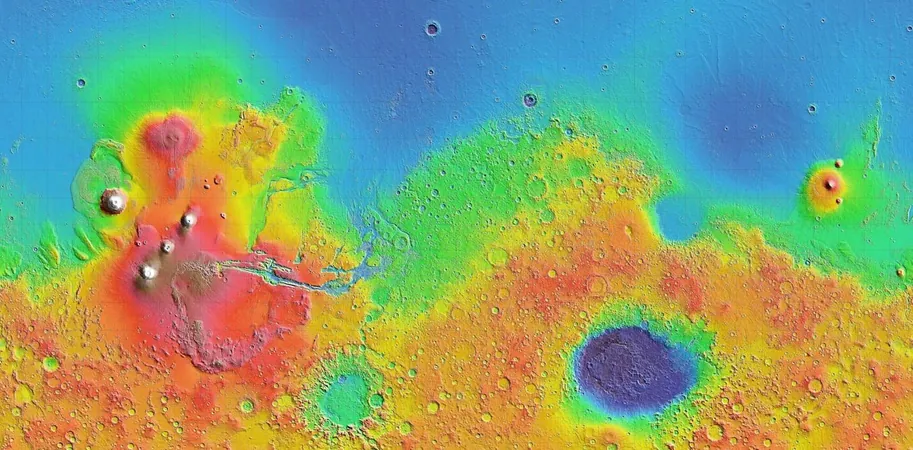
The Martian Mystery Unveiled: What 'Marsquakes' Reveal About the Planet's Splitting Secrets!
2025-01-18
Author: Mei
Mars continues to mystify scientists, especially with the perplexing phenomenon known as the Martian dichotomy—a striking contrast between its southern highlands and northern lowlands that has fascinated researchers since its discovery in the 1970s. Covering roughly two-thirds of the planet, the southern highlands rise 5 to 6 kilometers higher than the flat, smooth northern lowlands, an unusual feature that stands unrivaled in our solar system.
What lies at the heart of this stark difference? Researchers have long debated whether this disparity stemmed from external forces, such as a colossal moon-sized asteroid impact, or if it was more about internal dynamics, like the heat flow from Mars’ molten core.
A groundbreaking study published in *Geophysical Research Letters* leverages data from NASA's InSight lander to shed light on this enigma. By examining marsquakes—vibrations caused by seismic activity on Mars—scientists have gathered compelling evidence that suggests the Martian dichotomy's origins are deeply rooted within the planet.
Exploring the Dichotomy
Apart from altitude differences, the southern highlands are adorned with craters and streaks of ancient volcanic flows, while the northern lowlands present a much smoother façade with far fewer visible geological scars. The crust of Mars is notably thicker beneath the southern highlands, where rocks exhibit signs of having been magnetized in a bygone era when Mars boasted a global magnetic field—this is in stark contrast to the unmagnetized northern rock formations.
The discovery of the Martian dichotomy was a pivotal moment in planetary science; images from the Viking probes made it obvious that the density and height variations across Mars' surface were remarkable. Intriguingly, the southern highlands are believed to be older than their northern counterpart, given the surface density of impact craters—more craters equate to older geological surfaces.
Furthermore, scientific consensus suggests that Mars may have once hosted a vast ocean, potentially existing in areas now categorized as northern lowlands. However, this claim continues to fuel an ongoing debate, emphasized by the geological features, sediments, and mineral evidence collected.
The Theories: Inner Force vs. Cosmic Catastrophe
The origins of the Martian dichotomy hinge on two leading hypotheses. The **endogenic hypothesis** posits that the differential heat transfer within Mars' mantle contributed to the visible divisions on the surface. Conversely, the **exogenic hypothesis** suggests that a monumental cosmic impact caused the harsh divisions we observe today.
**Marsquakes** are key in unraveling this mystery. Unlike Earth, where seismic activity can be localized using vast arrays of seismometers, we only have data from InSight’s singular instrument. By calculating difference in P and S wave arrival times, scientists can triangulate marsquake locations.
Through this methodology, researchers have pinpointed a cluster of marsquakes in the southern highlands, providing critical insights into the internal structure of Mars. Their findings indicated that S waves lost energy more rapidly in the southern region, suggesting that the underlying rock is hotter than that found in the northern lowlands.
Insights and Future Directions
This temperature discrepancy bolsters the argument that internal forces crafted the Martian dichotomy. Researchers propose that an original uneven crust may have existed during Mars’ early formation when tectonic plates were active. The eventual cessation of plate movement led to a "stagnant lid," essentially freezing the dichotomy into place while convection patterns in the molten interior continued to evolve.
To unravel the full tapestry of the Martian dichotomy's origins, scientists will require further marsquake data and thorough models of Mars’ geological history, drawing parallels with Earth and other planetary bodies.
As we delve deeper into these cosmic questions, our understanding of Mars—and potentially the story of life's possibilities on other planets—may soon unfold, revealing the secrets that have eluded scientists for decades! Don't miss out on future updates in this captivating journey through the cosmos!



 Brasil (PT)
Brasil (PT)
 Canada (EN)
Canada (EN)
 Chile (ES)
Chile (ES)
 Česko (CS)
Česko (CS)
 대한민국 (KO)
대한민국 (KO)
 España (ES)
España (ES)
 France (FR)
France (FR)
 Hong Kong (EN)
Hong Kong (EN)
 Italia (IT)
Italia (IT)
 日本 (JA)
日本 (JA)
 Magyarország (HU)
Magyarország (HU)
 Norge (NO)
Norge (NO)
 Polska (PL)
Polska (PL)
 Schweiz (DE)
Schweiz (DE)
 Singapore (EN)
Singapore (EN)
 Sverige (SV)
Sverige (SV)
 Suomi (FI)
Suomi (FI)
 Türkiye (TR)
Türkiye (TR)
 الإمارات العربية المتحدة (AR)
الإمارات العربية المتحدة (AR)